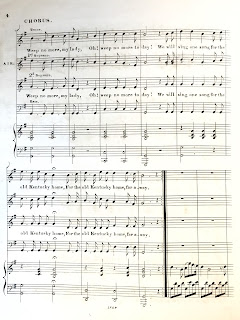 This state song of Kentucky is performed at the start of the annual Kentucky Derby. But, do you know what it is you are singing? “My Old Kentucky Home, Good-Night!” was originally written for minstrel singers. The song is narrated from the perspective of a slave who is being sold south because his Kentucky plantation master has gone bankrupt. All of the other slaves on the plantation are sent to freedom, but this slave sings that he will long for his “old Kentucky home” when he is sold to a southern plantation.
This state song of Kentucky is performed at the start of the annual Kentucky Derby. But, do you know what it is you are singing? “My Old Kentucky Home, Good-Night!” was originally written for minstrel singers. The song is narrated from the perspective of a slave who is being sold south because his Kentucky plantation master has gone bankrupt. All of the other slaves on the plantation are sent to freedom, but this slave sings that he will long for his “old Kentucky home” when he is sold to a southern plantation.Stephen C. Foster's family supported slavery, but some scholars now argue that he changed his views on slavery in the early 1850s, which makes this suggestion that the southbound slave will fondly miss his Kentucky enslavement very puzzling. Also, it’s a minstrel song, intended for white actors to sing in blackface – anything but progressive.
 So what was Foster thinking? He was originally from Pittsburgh, but he frequently visited his cousin, John Rowan, and his wife, Ann, at their property in Bardstown, Kentucky. It was at this Kentucky farm that Foster gained his first-hand exposure plantation life. Foster’s song was released in 1852, the same year as the publication of Harriet Beecher Stowe’s abolitionist novel Uncle Tom’s Cabin. Foster initially entitled the tune “Poor Old Uncle Tom, Good-Night!” but finalized the title to “My Old Kentucky Home, Good-Night!” as we know it today.
So what was Foster thinking? He was originally from Pittsburgh, but he frequently visited his cousin, John Rowan, and his wife, Ann, at their property in Bardstown, Kentucky. It was at this Kentucky farm that Foster gained his first-hand exposure plantation life. Foster’s song was released in 1852, the same year as the publication of Harriet Beecher Stowe’s abolitionist novel Uncle Tom’s Cabin. Foster initially entitled the tune “Poor Old Uncle Tom, Good-Night!” but finalized the title to “My Old Kentucky Home, Good-Night!” as we know it today.So as you sip on your mint julep on Saturday, ponder the irony of your “Old Kentucky Home.” To see the sheet music, ask for William/Watson SF 30.
Posted for Regan Roberts '16.


